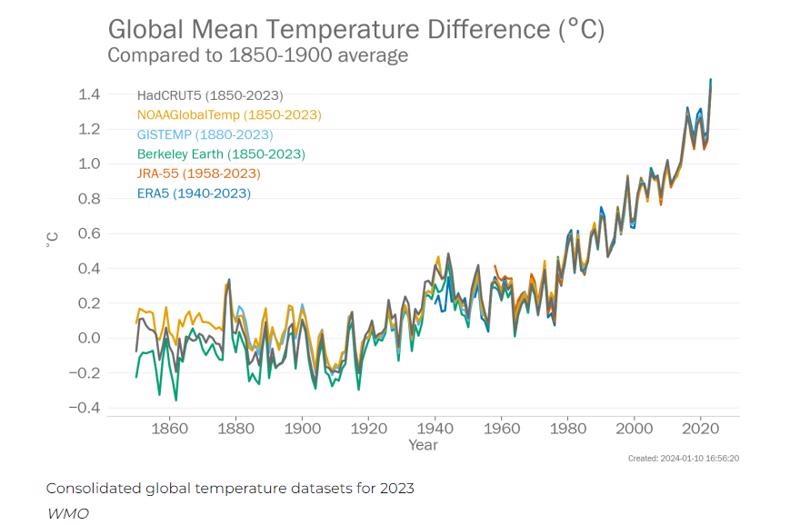
It's official: 2023 was the warmest year since the pre-industrial period
by Daria Blackwell 13 Jan 2024 23:06 UTC

Global Mean Temprature Difference © WMO
Marine heatwaves were also recorded around the globe, including in parts of the Mediterranean, Gulf of Mexico, Caribbean, Indian Ocean, North Pacific, and much of the North Atlantic.
This week, the European Union's Copernicus Climate Change Service (CCCS), the United Nations World Meteorological Organization (WMO), and the United States' National Oceanic and Atmospheric Association (NOAA) revealed that last year didn't just break the 2016 heat record, it shattered it. Last year's average temperature was 14.98C, which beats 2016 by 0.17C and comes perilously close to the 1.5C threshold that nations agreed to respect in the 2015 Paris climate accords.
The reports highlight several record-breaking conditions, including the hottest month on record, the most days above 1.5C anomaly, and daily global temperature averages briefly surpassing pre-industrial levels by more than 2C. Some climate scientists have likened it to changes in body temperature whereby a difference of 1C can distinguish a healthy person from one with a fever indicating illness.
Global average Sea Surface Temperatures (SST) were persistently and unusually high, reaching record levels for the time of year from April through December as the earth transitioned to El Niño.
A large number of extreme events were recorded across the world, including heatwaves, floods, droughts, and wildfires. According to an analysis of the international disaster database EM-DAT by Save the Children, at least 12,000 people (30% more than in 2022) lost their lives due to around 240 extreme climate-related events globally in 2023.
The NOAA National Centers for Environmental Information (NCEI) has released the final update to its 2023 Billion-dollar disaster report, confirming a historic year in the number of costly disasters and extremes throughout much of the United States. There were 28 weather and climate disasters in the US in 2023, surpassing the previous record of 22 in 2020, tallying a price tag of at least $92.9 billion.
2023 was remarkable for Antarctic sea ice: it reached record-low extents for the corresponding time of the year in 8 months. Both the daily and monthly extents reached all-time minima in February 2023. Arctic sea ice extent at its annual peak in March ranked amongst the four lowest for the time of the year in the satellite record. The annual minimum in September was the sixth-lowest. SSTs have continued to increase into the beginning of the New Year.
Quick Links:
This article has been provided by the courtesy of the Ocean Cruising Club.